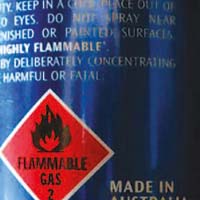
|
Silverback |
|---|
Dangerous goods regulations define gases as substances with a vapour pressure of 300 kPa or greater at 50°c or entirely gaseous at 20°c at normal atmospheric pressure, and items containing these substances. Class 2 encompasses compressed gases, liquefied gases, dissolved gases, refrigerated liquefied gases, mixtures of one or more gases with one or more vapours of substances of other classes, articles charged with a gas and aerosols.
Dangerous gases are mainly carried under pressure to reduce their volume and save space in transport and storage.
An empty or partially filled gas container containing a dangerous substance is treated the same as a full container and is subject to all the relevant transport dangerous goods regulations. Gas containers, when empty, can only be treated as non-hazardous if adequate measures have been taken to nullify any hazards.
Gases can pose severe hazards due to their flammability, potential asphyxiants, ability to oxidize, and toxicity to humans.
Aerosols, Compressed air, Hydrocarbon gas-powered devices, Fire Extinguishers, Gas cartridges, Fertilizer ammoniating solution, Insecticide gases, Refrigerant gases, Lighters, Acetylene / Oxyacetylene, Carbon dioxide, Helium/helium compounds, Hydrogen/hydrogen compounds, Oxygen/oxygen compounds, Nitrogen/nitrogen compounds, Natural gas, Oil gas, Petroleum gases, Butane, Propane, Ethane, Methane, Dimethyl ether, Propene/propylene and Ethylene.

Class 2.1 flammable gases will readily ignite at a concentration of 13% or less in air and have a flammable range of at least 12% regardless of the lower flammability limit. They may be lighter or heavier than air. Heavier than air gases can collect in low lying areas such as pits, depressions, and drains causing a fire and explosion hazard. Class 2.1 flammable gas labels are designed to stick...
Class 2.2 non-flammable non-toxic gases are asphyxiants (gases that dilute or replace the oxygen in the atmosphere); or are oxidizing (gases which may, generally by providing oxygen, cause or contribute to the combustion of other material more than air does). When asphyxiating gases are heavier than air they can collect in low lying areas and cause suffocation by the dilution or displacement of...
Class 2.3 toxic gases may cause death or injury on inhalation. Many of these also have other properties (e.g. may be flammable, oxidizing or corrosive). Class 2.3 is never used as a subsidiary risk. If a material meets the criteria it will be classified as a toxic gas.Eg: Anhydrous Ammonia, Methyl Bromide, Sulphur Dioxide, Carbon Monoxide.Class 2.3 Toxic Gas labels are designed to stick to...
Class 2.4 oxidizing gases although non-flammable, can accelerate combustion and increase the risk of fire in the presence of combustible or flammable materials. Eg: Nitrous Oxide, Entonox. Class 2.4 Oxidizing Gas labels are designed to stick to Emergency Information Panels (EIP's), shipping containers, IBC's and hazardous gas substances stored or transported. Available Materials and Sizes...